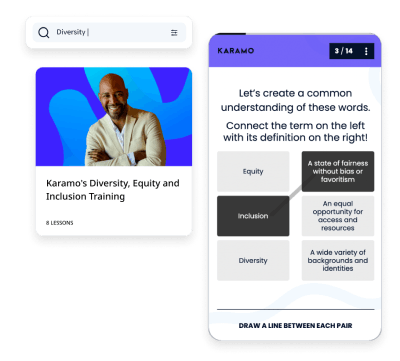10 Examples of cognitive dissonance in the workplace

In today's dynamic workplaces, the interplay between personal values and professional responsibilities often gives rise to cognitive dissonance. As you recognize instances of cognitive dissonance, you can address ethical dilemmas, enhance employee well-being, and align company practices with stated values.
This knowledge also helps your team navigate these challenges more effectively. It promotes healthier workplace cultures and ultimately bolsters overall productivity and satisfaction.
What is cognitive dissonance theory?
Leon Festinger’s Cognitive Dissonance Theory proposes that individuals experience psychological discomfort when confronted with conflicting beliefs, attitudes, or behaviors. This motivates people to seek harmony and consistency within their minds, prompting them to either change their beliefs, modify their actions, or rationalize their choices.

The theory suggests that resolving cognitive dissonance is crucial for maintaining mental equilibrium. People are driven to reduce this dissonance by aligning their thoughts, attitudes, and behaviors in ways that minimize internal conflict.
Signs of cognitive dissonance

Signs of cognitive dissonance often include observable behaviors and psychological responses. Recognizing these signs can help identify instances of cognitive dissonance and offer opportunities for resolution through introspection, adjustment of beliefs, or behavioral changes. Examples of these signs include the following:
- Increased stress, anxiety, or inner turmoil
- Avoidance behaviors, such as evading conversations or situations that challenge conflicting beliefs
- Rationalization or justification to explain or downplay inconsistencies between attitudes and actions
- Selective exposure to information that supports existing beliefs while avoiding contradictory evidence
- Attempting to find common ground or compromise to reduce the discrepancy between beliefs
- Defensive reactions when confronted with opposing viewpoints
- Difficulty in making decisions due to conflicting thoughts
How does cognitive dissonance affect the workplace?
Cognitive dissonance has a significant impact on the workplace. It influences employees' attitudes, behaviors, and overall dynamics. It can also lead to reduced job satisfaction, lower morale, and increased stress.

Your employees may struggle to reconcile their values with company policies or unethical practices. This potentially results in decreased engagement and motivation. Also, cognitive dissonance can hinder effective decision-making as rationalizing their professional choices to align with their existing beliefs makes it more difficult.
Understanding these effects of cognitive dissonance psychology can help you take proactive measures to minimize its negative impact. Addressing it also fosters a more transparent and ethical work environment and improves employee well-being.
1. Personal Growth and Stagnation
Your employee's strong desire for professional advancement can clash with the reality of being confined to a role that restricts chances for skill development and career progression. Cognitive dissonance intensifies as they recognize the mismatch between their aspirations and their current limitations.

To address this, you could establish a career development program that includes regular skill-building workshops, mentorship opportunities, and cross-functional projects. This initiative would align your employee's growth objectives with avenues for skill development. This minimizes the dissonance and encourages a more engaged and fulfilled workforce.
You can fulfill your employees’ desire for personal and professional growth with SC Training (formerly EdApp), an award-winning microlearning platform. SC Training (formerly EdApp) offers bite-sized courses on essential skills such as communication, leadership, and teamwork.

You can check these out and over 1,000 courses on SC Training (formerly EdApp)’s editable course library. All you have to do is create an account, import your desired courses, and seamlessly deliver them to your team members!

You can even edit the courses to fit your organization’s specific training and branding needs. Just use SC Training (formerly EdApp)’s intuitive drag-and-drop creator tool to customize them. You can also get help from SC Training (formerly EdApp)’s expert instructional designers by availing of the add-on course creation services.

Sign up to SC Training (formerly EdApp) to guide your team in reaching their personal and professional goals.
2. Employee Loyalty and Criticizing the Company
Sometimes, employees experience the urge to express dissenting views against certain company policies or decisions. So, they may also feel cognitive dissonance when these views conflict with their commitment to your organization.

Your company can mitigate this by implementing an anonymous feedback system that allows your employees to voice their concerns without fear of being punished. This also shows them that your company values diverse perspectives and encourages respectful discourse.
This eases the dissonance, letting your employees contribute their insights while maintaining their commitment to the organization.
3. Employee Recognition and Compensation
Your employees can struggle with the contrast between regular praise for their efforts and a persistent feeling that they’re being inadequately compensated. This cognitive dissonance stems from the difference between their perceived value to the company and the financial rewards they’re getting.

Your organization can address this by establishing a transparent performance review and compensation system. This system should clearly communicate the link between exceptional contributions and appropriate pay raises or bonuses.
Making sure that recognition translates into tangible rewards also bridges the dissonance, promoting a sense of fairness and motivation among your employees.
4. Overwork and Job Satisfaction
Employees may experience cognitive dissonance when they find themselves working extended hours while believing that work-life balance is crucial for job satisfaction. Your organization should actively promote and prioritize work-life balance to lessen this dissonance.

You can do this by implementing flexible scheduling, encouraging breaks, and discouraging a culture of excessive overtime. As you align company practices with the value of work-life balance, your organization can help employees reconcile their beliefs with their actions. This reduces stress and enhances job satisfaction.
5. Workplace Diversity and Discrimination
If an employee who strongly supports equality and diversity observes discriminatory behavior within the workplace, they may feel cognitive dissonance. So, your organization should establish comprehensive diversity training programs to address this. These will educate all your employees about unconscious biases and discriminatory behaviors.

Encouraging open conversations about diversity issues and promoting an inclusive work culture can also help the employee reconcile their values with their actions. It fosters a more equitable and respectful environment.
6. Innovation and Risk Aversion
If your company claims to prioritize innovation while being reluctant to embrace risks or novel methods, your employees will notice this, raising the chances for cognitive dissonance. This is why your organization should establish an innovation-friendly environment that encourages calculated risk-taking. This should also reward creativity and offer resources for experimentation.

As you align your organization’s actions with the professed value of innovation, you can also help employees reconcile their perceptions with reality. This cultivates a culture that genuinely supports and rewards innovative thinking.
7. Remote Work and Micromanagement
When your employees are encouraged to embrace the flexibility of remote work while being micromanaged at the same time, they can experience cognitive dissonance. This is because micromanagement contradicts the autonomy typically associated with remote work.

To alleviate this, your organization should establish clear guidelines for remote work that emphasize trust and outcomes rather than constant supervision.
Empowering employees with independence, regular check-ins, and well-defined goals can help bridge the dissonance. This creates a remote work environment that aligns with the organization's values and enhances productivity and job satisfaction.
8. Leadership Styles and Employee Behavior
This cognitive dissonance manifests when a manager, who claims to value participatory leadership, constantly makes decisions without involving their team. The dissonance arises from the difference between their leadership philosophy and their actual behavior.

So, your managers should actively seek input from team members before making decisions. This helps create a collaborative decision-making process that aligns with desirable leadership values. By bridging this dissonance, your managers can cultivate a more inclusive and empowered team environment.
9. Health and Wellness Policies
When your organization champions health and wellness but contradicts its message by offering unhealthy snacks in the break room, cognitive dissonance emerges. Employees committed to adopting the healthy lifestyle advocated by your company may experience conflict between their desired choices and the given options.

To avoid cognitive dissonance, your organization should align its practices with its messaging by stocking the break room with nutritious snacks and beverages. Creating an environment that supports healthy choices can help your employees align their behaviors with your company’s promoted values.
This reduces cognitive dissonance and encourages a workplace culture that truly prioritizes health and wellness.
10. Environmental Concerns and Company Practice
Cognitive dissonance also turns up when an environmentally conscious employee faces the unsustainable practices of their workplace. To resolve this, your company should have a comprehensive sustainability initiative that aligns with the employee's values.

Implementing eco-friendly policies, reducing waste, and investing in renewable energy sources can bridge this dissonance. Allowing your employees to see their values reflected in the organization's actions fosters a more harmonious and environmentally responsible workplace.
Author
Donna Dane
Donna is an elearning content writer for SC Training (formerly EdApp), a mobile-based microlearning platform designed for today's digital training needs. When she's not writing web articles, she writes lines of code or songs or anything food-related.
